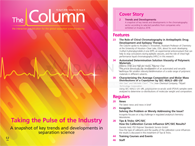Investigating the Role of Amino Acids in Celiac Disease Development
Researchers from the University of Gothenburg, in Gothenburg, Sweden, have investigated whether plasma amino acid levels differed among children with celiac disease using liquid chromatography–mass spectrometry (LC–MS) (1).
Photo Credit: KucherAV/Shutterstock.com

Researchers from the University of Gothenburg, in Gothenburg, Sweden, have investigated whether plasma amino acid levels differed among children with celiac disease using liquid chromatography–mass spectrometry (LC–MS) (1).
In the most recent decades the profile of celiac disease has risen immensely with the number of sufferers increasing thanks to improved diagnostics and recognition. The plight of sufferers has also became better known, and more recently their specialized diet has been subverted as a fad weight loss diet-further increasing the disease’s profile. Characterized by an intolerance to gluten, those suffering from celiac disease experience severe gastrointestinal distress in the form of abdominal pain and distension, diarrhoea, flatulence, nausea, and fatigue. However, celiac disease is not a mere food allergy. Both the innate and adaptive immune pathways are triggered, resulting in antibodies that target both gluten and the body’s own proteins causing damage to the intestinal mucosa. As such, the disease is generally considered an autoimmune condition.
Excluding gluten from the diet allows the damaged intestines of sufferers to repair, however, the mechanisms by which autoimmunity can be switched on and off by gluten intake still remain unresolved. Furthermore, what causes people to develop the disease in the first place remains unknown. Genetics appear to play a role because almost all diagnosed patients have mutations in two specific genes that allow the immune system to distinguish self from non-self and coordinate T-cell activity. However, these genetic factors appear to only partially dictate the pathogenesis because around 40% of people have these genes and yet not all go on to develop celiac disease (2).
In a previous paper, researchers carried out a Genome Wide Association Study (GWAS), which identified links towards genes involved in nutrient and amino acid signalling (3). Amino acid profiles have a well-established role in other chronic diseases such as type 2 diabetes (4–7), Alzheimer’s disease (8), or autism (9), where sufferers often have different amino acid profiles to those who are healthy. Several of the genes identified in the GWAS belonged to the Target of Rapamycin (TOR) pathway (10), a well-studied signalling pathway connecting amino acid signalling and immunity. Furthermore, the study revealed a connection between extra cellular matrices, which can act as a storage reservoir for certain amino acids, and celiac disease. The researchers hypothesized that certain amino acids, released following the breakdown of gluten, were involved in the signalling pathway of the immune system and ultimately led to chronic inflammation.
To investigate, researchers analyzed blood samples from children with and without the disease using LC–MS. The study found that children with untreated celiac disease had increased levels of seven amino acids when compared to healthy children. These findings suggest that the metabolism of amino acids could be responsible for the inflammation experienced by those with celiac disease. However, it is still unclear if these increased levels of amino acids are a result of the inflammation and not the cause. It could also be the case that the increased levels of amino acids are the result of a genetic predisposition in combination with environmental risk factors. Future studies are required to investigate these possibilities and fully understand where increased levels of amino acids fit within celiac disease pathogenesis. - L.B.
References
- Å.T. Naluai et al., PLoS ONE13(3), e0193764 (2018).
- https://www.the-scientist.com/?articles.view/articleNo/49467/title/The-Celiac-Surge [Accessed 24/03/18]
- M. Östensson et al., PLoS One8, (2013).
- Y. Zhou et al., Clin. Biochem.46, 1447–1452 (2013).
- H. Nakamura et al., Nurt. Diabetes 4, e133 (2014).
- B.A. Menge et al., Regul. Pept. 160, 75–80 (2010).
- E.P. Wijekoon, C. Skinner, M.E. Brosnan, and J.T. Brosnan, Can. J. Physiol. Pharmacol.82, 506–514 (2004).
- A.N. Fonteh et al., Amino Acids32, 213–224 (2007).
- S. Aldred et al., J. Autism Dev. Disord.33, 93–97 (2003).
- S.G. Dann and G. Thomas, FEBS Letters 2821–2829 (2006).

Advances in Non-Targeted Analysis for PFAS in Environmental Matrices
March 27th 2025David Megson from Manchester Metropolitan University in Manchester, UK, spoke to LCGC International about the latest developments in non-targeted analysis (NTA) of per- and polyfluoroalkyl substances (PFAS) in environmental matrices based on a recent systematic review paper he has collaboratively published (1).
Analytical Challenges in Measuring Migration from Food Contact Materials
November 2nd 2015Food contact materials contain low molecular weight additives and processing aids which can migrate into foods leading to trace levels of contamination. Food safety is ensured through regulations, comprising compositional controls and migration limits, which present a significant analytical challenge to the food industry to ensure compliance and demonstrate due diligence. Of the various analytical approaches, LC-MS/MS has proved to be an essential tool in monitoring migration of target compounds into foods, and more sophisticated approaches such as LC-high resolution MS (Orbitrap) are being increasingly used for untargeted analysis to monitor non-intentionally added substances. This podcast will provide an overview to this area, illustrated with various applications showing current approaches being employed.
Multi-Step Preparative LC–MS Workflow for Peptide Purification
March 21st 2025This article introduces a multi-step preparative purification workflow for synthetic peptides using liquid chromatography–mass spectrometry (LC–MS). The process involves optimizing separation conditions, scaling-up, fractionating, and confirming purity and recovery, using a single LC–MS system. High purity and recovery rates for synthetic peptides such as parathormone (PTH) are achieved. The method allows efficient purification and accurate confirmation of peptide synthesis and is suitable for handling complex preparative purification tasks.














